Educational Resource Spotlight: TRACK Magnet
Order This and Other Materials
Healthy Vision Community Programs Database
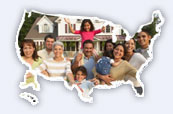
This easy-to-search resource can help you learn about new ways to address eye health issues and replicate eye health-related projects in your community. Visit the Healthy Vision Community Programs Database at http://community-based.icfwebservices.com/.
Contact Us
Send us your story ideas, eye health events, or articles you'd like to see in future issues of Outlook.
The National Eye Health Education Program is coordinated by the National Eye Institute, National Institutes of Health, U.S. Department of Health and Human Services. This administrative document may be reprinted without permission.
In This Issue:
Healthy Eating Habits May Delay Age-Related Macular Degeneration
Lighthouse International: Implementing "The ABCs of Diabetes" in a Vision Practice
Healthy Vision Community Award Spotlight: Third Avenue Charitable Organization, Inc.
Now You Can Listen to the National Eye Institute What you should know Series Publications

NEHEP: Making Science a Perfect Instrument
Carl G. Jung (1875-1961) once wrote, "Science is not . a perfect instrument, but it is a superb and invaluable tool that works harm only when taken as an end in itself." When one considers the years and dollars of investment in basic and clinical research since the inception of the National Eye Institute (NEI), and what we have learned from the studies and trials that have emerged as "products," it is astounding. As one of those researchers, in at least three glaucoma trials, I can attest to the joy of completing studies, sharing in the writing of primary outcome papers, and presenting the results at professional meetings. However, when there are opportunities to share the same information with individuals, with and without eye disease, and make a difference in their lives, it is indeed exciting and makes all the effort a meaningful endeavor.
The National Eye Health Education Program (NEHEP) has been the program that has made science helpful to the community at large by extending this invaluable tool beyond the boundaries of the academic research environment. In this, my last introduction to Outlook, I would like to thank each and every one of the past and current members of the NEHEP Planning Committee. I would also like to thank Dr. Carl Kupfer, who initially involved me with the Planning Committee more than 15 years ago, Mr. Ed McManus for his guidance through the early stages of the development of the programs, and Ms. Judith Stein and Ms. Rosemary Janiszewski who provided the enthusiasm in the eye community, which helped to grow the membership and change policy. As a special note, I would like to thank Ms. Janiszewski for her leadership and persistence in finally getting vision objectives listed as part of Healthy People 2010 and for her friendship, as we often met and discussed the direction and plans for this program. Moreover, none of these initiatives could have continued to survive without the support of NEI's Drs. Paul Sieving and Jack McLaughlin.
Looking back during the years of my leadership from 2003 to 2008, there have been several major milestones that should be highlighted. As Dr. Al Sommer transitioned out of the role of chair, the Low Vision Program of NEHEP was in the process of being developed. During past National Eye Health Education Conferences, programs for community outreach for glaucoma, diabetes, and low vision have been notably enhanced. The following are just a few programs and initiatives that have advanced our efforts during my tenure as chair:
- Since 2003, the annual celebration of May as Healthy Vision Month has provided us an opportunity to promote the vision objectives in Healthy People 2010.
- Since 2003, the Healthy Vision Community Awards program continues to seed innovative projects which advance the Healthy People 2010 objectives. To date, we have funded a community award in nearly every state and U.S. territory.
- In 2005, a database of Healthy Vision Community Programs was launched, providing a resource for individuals and groups who are interested in launching their own local program.
- In 2005, NEHEP completed its second public survey of Knowledge, Attitudes, and Practices Related to Eye Health and Disease in partnership with the Lions Clubs International Foundation. Results will soon appear in peer-reviewed publications.
- In 2006, the first NEHEP Action Plan was launched to provide goals and objectives for the program for the next five years.
- In 2008, the NEHEP Planning Committee met at the National Center for Primary Care at the Morehouse School of Medicine to determine how best to strengthen partnerships between the eye community and primary care.
- In 2008 there have been a number of new publications and the NEHEP Website was redesigned.
As you can see, these last five years have been exceedingly busy. I have been very proud to be a part of such an important initiative. However, there is more work to be done and it is time for the infusion of new ideas and people. Thus, I am very pleased to pass the baton to one of my former residents, who has been extraordinarily successful in her own career, Dr. Anne Coleman, Professor of Ophthalmology at the Jules Stein Eye Institute. I know NEHEP will be in very good hands and I look forward to witnessing its exponential growth in the years to come. Indeed, contrary to Carl Jung's quote, this science from the NEI is an effective tool because it is used to change lives and thus make a difference.
Eve Higginbotham, M.D.
Chair, National Eye Health Education Program Planning Committee
Dean and Senior Vice President of Academic Affairs
Morehouse School of Medicine
Atlanta, GA
KAP Highlight: Diabetic Eye Disease
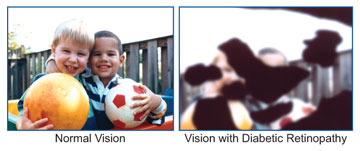 Diabetes has become an epidemic in the United States, and projections for new cases in the coming years are alarming. In 2007, 23.6 million people were estimated to have diabetes, representing approximately 7 percent of the U.S. population. More than 4 million Americans (3.4%) aged 40 and older have some form of diabetic retinopathy, the most common type of diabetic eye disease (DED). This number is projected to reach 6.1 million by the year 2020.1
Diabetes has become an epidemic in the United States, and projections for new cases in the coming years are alarming. In 2007, 23.6 million people were estimated to have diabetes, representing approximately 7 percent of the U.S. population. More than 4 million Americans (3.4%) aged 40 and older have some form of diabetic retinopathy, the most common type of diabetic eye disease (DED). This number is projected to reach 6.1 million by the year 2020.1
The Knowledge, Attitudes, and Practices Related to Eye Health and Disease (KAP) Survey, a national survey conducted in English and Spanish by the National Eye Institute and the Lions Clubs International Foundation provides information about DED.
In terms of general health, 47 percent of adults with DED describe their health as good, very good, or excellent compared with 83 percent of all adults who describe their health the same way. Ninety-five percent of adults with DED report having visited a healthcare provider (HCP) within the past two years.
Among adults with DED, 85 percent report that they had heard of the disease before being diagnosed with it. Only 51 percent of all adults report having heard of DED. All adults with DED and 85 percent of all adults report knowing that people with diabetes should have a dilated exam at least once a year. Seventy-seven percent of adults with DED and 69 percent of all adults report knowing that vision loss caused by diabetes can be prevented. Only 11 percent of adults with DED and 11 percent of all adults report knowing, however, that eye disease caused by diabetes usually has no early warning signs.
When asked about eye care practices, 89 percent of adults with DED and 91 percent of all adults report ever having had their eyes examined by an HCP, which could have included a primary care provider (PCP) or an eye care provider. Of adults who have had their eyes examined, 93 percent of adults with DED and 76 percent of all adults report having had their eyes dilated during the exam.
The top three reasons for having an eye exam among adults with DED are having a regular checkup (59%); having trouble seeing (25%); and having an eye infection, eye injury, or eye disease (3%). Results from the KAP Survey found that recommendations from PCPs, family members, and coworkers had the greatest influence among adults with DED to have an eye exam.
The KAP Survey findings highlight the need to educate all adults about the importance of regular comprehensive dilated eye examinations that will facilitate the timely discovery of DED, especially since so few know that there are usually no early warning signs. The National Eye Health Education Program (NEHEP) is using the survey information to continue to develop and implement targeted efforts to raise awareness about DED. Other organizations can use these findings in developing their own eye health education outreach.
To learn more about NEHEP activities, resources, and materials on DED, visit www.nei.nih.gov/nehep/programs/diabeticeyedisease/index.asp.
For more information about the KAP Survey and to download a full copy of the report, visit www.nei.nih.gov/kap/.
Reference
1 Eye Diseases Prevalence Research Group. (2004). Prevalence of diabetic retinopathy among adults in the United States. Archives of Ophthalmology, 122(4), 552-63.
Diabetic Eye Disease: What You Can Do to Make a Difference
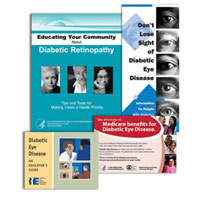 Diabetic eye disease (DED) is a complication of diabetes. DED refers to a group of eye problems and includes diabetic retinopathy-the most common DED, cataract, and glaucoma. All can cause severe vision loss or even blindness. There are often no symptoms in the early stages of DED.
Diabetic eye disease (DED) is a complication of diabetes. DED refers to a group of eye problems and includes diabetic retinopathy-the most common DED, cataract, and glaucoma. All can cause severe vision loss or even blindness. There are often no symptoms in the early stages of DED.
Healthcare practice guidelines recommend a dilated eye exam at least once a year for all people with diabetes because early diagnosis, timely treatment, and follow-up have been shown to prevent vision loss in more than 90 percent of patients. Studies indicate, however, that many people with diabetes do not get an annual dilated eye exam. An estimated 50 percent of patients are diagnosed too late for treatment to be effective.
You can help raise public awareness about the need for people with diabetes to have dilated eye exams by distributing information to your family, friends, coworkers, and mailing list members. NEI has a variety of materials in English and Spanish, including public service announcements (PSAs), brochures, posters, teaching resources for health professionals, and more.
The following are examples of materials and ideas about how to use them. You can find them at www.nei.nih.gov/diabeteseducation.
What You Can Do: Inform health professionals about this easy-to-read flipchart to educate their patients with diabetes about important steps they can take to protect their vision.
How You Can Do It: Contact local hospitals, health clinics, and organizations that offer individual and group classes for people with diabetes to let them know about this resource. There is also a downloadable announcement about the Educator's Guide to post on websites or in newsletters that reach health professionals who work with people with diabetes.
What You Can Do: Help others obtain the diabetic eye disease and glaucoma benefit under Medicare. The card contains information about benefit eligibility and where to go to learn more.
How You Can Do It: Distribute at health fairs, clinics, and other community locations. Place cards in your cafeteria or lunch room with a note to "Take one for someone you care about." Work with local pharmacies to make the cards available to their customers.
What You Can Do: Link others to a consumer-friendly site where they can learn about early detection, treatment, and follow-up care for diabetic eye disease.
How You Can Do It: Post the link on your intranet or website. Include information about the website in e-mails and newsletters to your constituents.
Don't Lose Sight of Diabetic Eye Disease (brochure)
What You Can Do: Make sure that eye care providers in your community know about the brochure.
How You Can Do It: Stop in at local eye care provider offices and ask them to make it available to their patients. Leave a copy and be sure to provide information about how they can order a supply.
What You Can Do: Find opportunities to have the magnet included with diabetes medications and supplies.
How You Can Do It: Ask local pharmacists and medical supply establishments to include a magnet when prescriptions or supplies for diabetes care are picked up.
Print and Radio Public Service Announcements (PSAs)
What You Can Do: Enlist the mass media. NEI offers a variety of downloadable print and radio PSA scripts about the importance of dilated eye exams.
How You Can Do It: Use our ready-made scripts to record PSAs that your organization can play on your hold line or distribute to local radio stations. Download print PSAs, available in a variety of sizes, and ask the editor of your local newspaper to run it.
Don't Lose Sight of Diabetic Eye Disease (drop-in article)
What You Can Do: Let people with diabetes and those who care about them know about the importance of having a dilated eye exam at least once a year.
How You Can Do It: Put this article in your company or organizational newsletter or post it on your company bulletin board or intranet. Contact the marketing or health education department at the nearest hospital to see if they can place the article in the publication that they produce and distribute to the community. Get in touch with a newspaper health editor and request that the article be printed.
For more ideas, download Educating Your Community about Diabetic Retinopathy. This resource, part of the Healthy Vision 2010 Toolkit, contains facts about diabetic retinopathy, activity suggestions, promotional materials, and a reproducible brochure. An electronic version is available at www.healthyvision2010.org/toolkit/_documents/pdf/DR_Booklet.pdf.
Healthy Eating Habits May Delay Age-Related Macular Degeneration
 Approximately 10 million Americans suffer from age-related macular degeneration (AMD), a devastating eye disease and the leading cause of vision loss in people 65 years or older in the United States. Although there is no cure for AMD, recent studies show that by eating foods rich in antioxidants and vitamins, you may slow the progression of AMD.
Approximately 10 million Americans suffer from age-related macular degeneration (AMD), a devastating eye disease and the leading cause of vision loss in people 65 years or older in the United States. Although there is no cure for AMD, recent studies show that by eating foods rich in antioxidants and vitamins, you may slow the progression of AMD.
In light of this, EyeCare America, a public service program of the Foundation of the American Academy of Ophthalmology, has teamed up with celebrity chefs from across the country to provide healthy recipes that include foods rich in vitamins and antioxidants. Celebrity chefs participating in the campaign include Devin Alexander, Janette Barber, Domenica Catelli, Jim Coleman, Jill Davie, Khai Duong, Mr. Food, Jeff Fournier, Mary Beth Lawton Johnson, David Lawrence, Maria Liberati, Kate McAloon, Jeff Moschetti, Rebecca Newell, Jyl Steinbeck, and Jeff Tsao. Recipes from each of the chefs are available online at www.eyecareamerica.org.
"Making a choice to get healthier with your eating choices can have such a huge effect on every aspect of your life," said Chef Janette Barber, former host of Food Network's Lighten Up. "My sister has cataract and macular issues. The state of her eyes affects everything. Learning that something as simple and wonderful as cooking healthy food can actually help is truly empowering."
So, what type of foods should you eat?
- Fruits and vegetables including oranges, grapefruit, strawberries, papaya, green peppers, and tomatoes.
- Almonds, pecans, wheat germ, and sunflower seeds.
- Deep orange or yellow fruits and vegetables such as cantaloupe, mangos, apricots, peaches, sweet potatoes, and carrots.
- Dark green leafy vegetables such as broccoli, collard greens, asparagus, and spinach.
- Beef, pork, lamb, oysters, eggs, shellfish, milk, peanuts, whole grains, and wheat germ.
Additionally, EyeCare America urges seniors to call their AMD EyeCare helpline at 1-866-324-EYES (3937) to see if they qualify for a free eye exam or to request free AMD educational materials. Callers who have not seen an ophthalmologist in three or more years may be eligible to receive a comprehensive medical eye exam and, in most cases, up to one year of care at no out-of-pocket cost for any disease diagnosed during the initial exam. The eye exams will be provided by more than 7,000 volunteer ophthalmologists across the United States.
For more information about EyeCare America's award-winning referral program and recipes from each of the celebrity chefs, visit their website at www.eyecareamerica.org.
Lighthouse International: Implementing "The ABCs of Diabetes" in a Vision Practice
 According to new statistics from the Centers for Disease Control and Prevention, 24 million Americans have diabetes-an alarming increase of 3 million people in only two years.
According to new statistics from the Centers for Disease Control and Prevention, 24 million Americans have diabetes-an alarming increase of 3 million people in only two years.
Diabetes affects many aspects of health, including vision. In fact, diabetes is the leading cause of new cases of blindness among people aged 20 to 74. Lighthouse International, a leading nonprofit organization is dedicated to preserving vision and providing vision rehabilitation to individuals of all ages. Lighthouse International has expanded services to include diabetes education and care. Individuals with diabetes can now receive education and comprehensive care by a team of Certified Diabetes Educators (CDEs) and a Diabetes Nurse Practitioner. Our philosophy is that vision loss is not an inevitable consequence of diabetes and, in those clients who experience initial vision loss or early diabetic retinopathy, it need not progress to blindness.
The Lighthouse International's Diabetes Center staff stress the prevention of vision loss through early detection and screening for at-risk communities through our outreach programs, partnership with organizations, and participation in health fairs. Through tight control of blood glucose, blood pressure, and cholesterol, individuals with diabetes can reduce the risk of vision loss and the progression of diabetic retinopathy from non-proliferative retinopathy to proliferative retinopathy. The Lighthouse International Diabetes Center works in collaboration with the client's primary care provider and/or endocrinologist to achieve these goals.
The Diabetes Center staff work one-on-one with the client. They follow the American Diabetes Association's ABCs of Diabetes:
A = A1c level, a blood test that indicates blood glucose control, should be at 7 percent or below. B = Blood pressure should be at 130/80 or less. C = Cholesterol (LDL) should be < 100 mg/dL. s = Stop smoking!
For many clients, this may be the first time that they are made aware of the ABCs of diabetes and the fact that, even for those with initial vision loss, diabetes control does matter in order to prevent other complications, such as cardiac and kidney disease. National Diabetes Education Program (NDEP) patient education materials are used and individualized depending on the client's level of vision impairment.
Clients with diabetes are provided with an individualized education plan that addresses their obstacles in reaching ABCs-related goals. Challenges with blood glucose monitoring, meal preparation, nutrition, and insulin administration are common issues shared by many individuals with diabetes. There are other available resources at the Lighthouse, such as the Mental Health Service Center to address emotional issues; Social Services to assist with access to care; Rehabilitation Services; and Career Services.
Founded in 1905, Lighthouse International is a leading nonprofit organization dedicated to preserving vision and to providing critically needed healthcare services to help people of all ages overcome the challenges of vision loss. Through services, education, research, and advocacy, the Lighthouse enables people with low vision and blindness to enjoy safe, independent, and productive lives. For more information about vision loss and its causes, contact Lighthouse International at 1-800-829-0500 or visit www.lighthouse.org.
"4 Steps to Control Your Diabetes for Life"
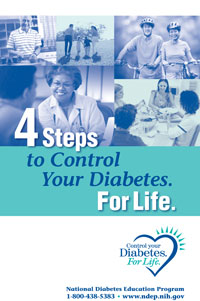 The National Diabetes Education Program (NDEP), a joint program of the National Institutes of Health and the Centers for Disease Control and Prevention, promotes the importance of preventing type 2 diabetes and managing diabetes to prevent or delay complications, including diabetic retinopathy.
The National Diabetes Education Program (NDEP), a joint program of the National Institutes of Health and the Centers for Disease Control and Prevention, promotes the importance of preventing type 2 diabetes and managing diabetes to prevent or delay complications, including diabetic retinopathy.
A centerpiece of NDEP's Control Your Diabetes. For Life. campaign is the patient education booklet, "4 Steps to Control Your Diabetes for Life," available in English, Spanish, and eight Asian and Pacific Islander languages. This easy-to-read booklet helps healthcare professionals educate patients in vital self-care principles. Written for people newly diagnosed with diabetes as well as those living with diabetes for years, the four steps help them understand, monitor, and manage their diabetes. Presented in a simple format, "4 Steps" empowers people with diabetes to be active partners in their own care and to take steps to stay healthy.
All NDEP materials are available for free, and they also are copyright-free. Many are available on printer-ready CDs, making it convenient for organizations to add their logo and print desired quantities. Visit the NDEP Website at www.YourDiabetesInfo.org, or call 1-888-693-NDEP (6337), TTY: 1-866-569-1162.
Healthy Vision Community Award Spotlight: Third Avenue Charitable Organization, Inc.
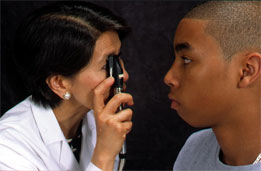 The Third Avenue Charitable Organization (TACO) in San Diego, has been providing health, law, and social services to residents of underserved neighborhoods for more than 30 years. As a 2008 Healthy Vision Community Award (HVCA) recipient, TACO is working to expand and enhance its monthly diabetic retinopathy and glaucoma screenings for the homeless, indigent, and working poor patients they serve in their ophthalmology clinic.
The Third Avenue Charitable Organization (TACO) in San Diego, has been providing health, law, and social services to residents of underserved neighborhoods for more than 30 years. As a 2008 Healthy Vision Community Award (HVCA) recipient, TACO is working to expand and enhance its monthly diabetic retinopathy and glaucoma screenings for the homeless, indigent, and working poor patients they serve in their ophthalmology clinic.
The primary goal of the A Brighter Horizon: Eye Education and Health Care for San Diego's Underserved Communities project is to educate residents about preventive eye care to avoid vision loss from diabetic retinopathy and glaucoma. A secondary objective of the project is to educate health providers who are responsible for the education, screening, and treatment of this population. These efforts will increase awareness among students, residents, and other healthcare providers about the importance of screening for diabetic retinopathy and glaucoma and help educate them about community vision care resources available to patients.
The project takes place in the context of a 10-year collaborative partnership between TACO and the University of California San Diego (UCSD) Student-Run Free Clinic Project. Newly diagnosed and existing patients with diabetes seen through TACO and its collaborators are specifically targeted to increase their awareness about the importance of annual comprehensive dilated eye examinations. Each screening clinic is attended by as many as three volunteer ophthalmologists, creating an environment where patients can immediately learn about their eye diseases. Typically, 10 to 12 medical students also attend the clinic to learn the basics of providing eye care and to hone patient communication skills.
Patients needing further care are referred to the appropriate eye care provider for their situation. Services are rendered free of charge by providers that include a retina specialist who provides laser treatment, ophthalmologists for cataract evaluations and surgeries, and optometrists for refractive services and general eye evaluations. TACO offers transportation to patients for all referral appointments.
Monthly education talks for patients are provided in English and Spanish by medical students who have had adequate training during healthcare provider educational workshops. The talks are held on the same night as the eye screening and concurrent diabetic screening clinic run by the USCD Free Clinic, so this subset of patients can be reached. Educational sessions are also given at local elementary schools, churches, and other sites accessible to the underserved population.
Some accomplishments of the TACO Brighter Horizon project include—
- Seeing more than 86 patients in the first six months who were all screened for diabetic retinopathy and glaucoma and had retina photos taken. Of these—
- More than 17 have been referred for free optometry appointments and have received glasses at no charge.
- Four have been referred to a retina specialist for further examination.
- Four have been referred for free cataract surgery by a volunteer specialist.
- Providing more than nine health education sessions to patients in both English and Spanish.
- Opening a satellite ophthalmic services site in an elementary school that makes access to care easy for neighborhood residents.
- Increasing clinic attendance as a result of ongoing efforts to build trust with the community and expand involvement of medical students, undergraduate students, technicians, ophthalmologists, and optometrists to offer more comprehensive eye care.
For more information about the A Brighter Horizon: Eye Education and Health Care for San Diego's Underserved Communities project, contact Jim Lovell, Project Coordinator, at 619-235-9445 or jim.chacha@firstlutheransd.org.
To learn more about the HVCA Program, visit www.healthyvision2010.org/news/hvca.
Now You Can Listen to the National Eye Institute What you should know Series Publications
 The National Eye Institute, National Institutes of Health, is pleased to announce that the What you should know series can now be heard! Available in English and Spanish, CD and audio cassette formats, the patient education series offers information on age-related macular degeneration, cataract, diabetic retinopathy, and glaucoma.
The National Eye Institute, National Institutes of Health, is pleased to announce that the What you should know series can now be heard! Available in English and Spanish, CD and audio cassette formats, the patient education series offers information on age-related macular degeneration, cataract, diabetic retinopathy, and glaucoma.
Each uses a question-and-answer approach to explain the disease or condition and provide information about: who is at risk, detection and treatment, research being done, vision protection, questions to ask an eye care professional, and where to get more information.
Since these eye diseases and conditions may cause vision loss, an audio version of What you should know about low vision is also included. In addition to defining low vision and identifying signs that can signal vision loss, there is information on how an eye care professional can help and examples of devices and services that can be of assistance.
Share this information with your colleagues and those you serve to let them know about the availability of these materials. CDs and cassettes can be ordered by calling 301-496-5248.
On the Road with NEI
![]() NEI regularly exhibits at national meetings across the country. Exhibits provide an opportunity to share information and publications, promote NEI messages and resources, and strengthen links with partner organizations. Upcoming NEI exhibits are listed below. If you plan to attend any of these meetings, please stop by and say "hello"!
NEI regularly exhibits at national meetings across the country. Exhibits provide an opportunity to share information and publications, promote NEI messages and resources, and strengthen links with partner organizations. Upcoming NEI exhibits are listed below. If you plan to attend any of these meetings, please stop by and say "hello"!
American Academy of Optometry
Annual Conference
Anaheim Convention Center
Anaheim, CA
October 21-24, 2008
Booth Number 853
American Public Health Association
Annual Meeting & Exposition
San Diego Convention Center
San Diego, CA
October 25-29, 2008
Booth Number 1109
*PDF files require the free Adobe® Reader® software for viewing. Attention people with visual disabilities: please visit access.adobe.com to work more effectively with PDF files.
Need help working with PDF files?

